Welch Allyn 300 User manual
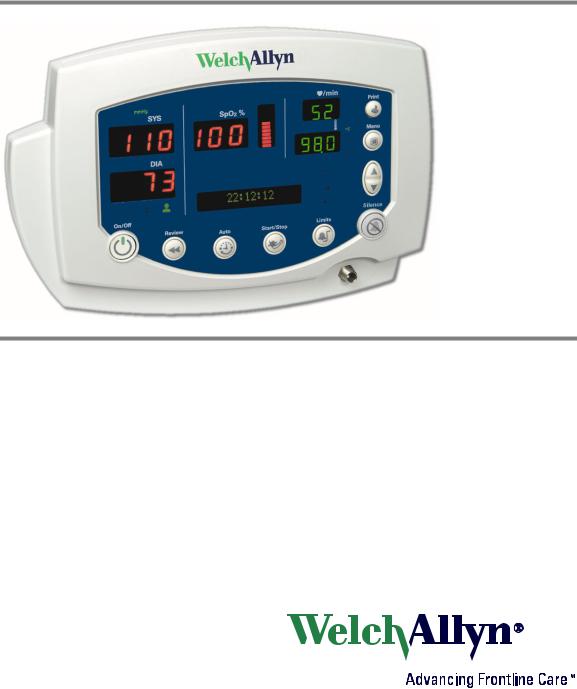
Vital Signs Monitor
300 Series
Directions for Use
Software version 1.2X

ii |
Welch Allyn Vital Signs Monitor 300 Series |
Copyright 2005 Welch Allyn. All rights are reserved. No one is permitted to reproduce or duplicate, in any form, this manual or any part thereof without permission from Welch Allyn.
Welch Allyn assumes no responsibility for any injury to anyone, or for any illegal or improper use of the product, that may result from failure to use this product in accordance with the instructions, cautions, warnings, or statement of intended use published in this manual.
Welch Allyn® and Flexible Monitoring® are registered trademarks of Welch Allyn. FlexNet™ is a trademark of Welch Allyn.
SET®, LNOP®, and Masimo® are registered trademarks of Masimo Corporation. Possession or purchase of a Masimo SpO2-equipped monitor does not convey any express or implied license to use the device with unauthorized sensors or cables which would, alone or in combination with this device, fall within the scope of one or more of the patents relating to this device.
Software in this product is Copyright 2005 Welch Allyn or its vendors. All rights are reserved. The software is protected by United States of America copyright laws and international treaty provisions applicable worldwide. Under such laws, the licensee is entitled to use the copy of the software incorporated with this instrument as intended in the operation of the product in which it is embedded. The software may not be copied, decompiled, reverse-engineered, disassembled or otherwise reduced to human-perceivable form. This is not a sale of the software or any copy of the software; all right, title and ownership of the software remains with Welch Allyn or its vendors.
For information about any Welch Allyn product, please call Welch Allyn Technical Support:
USA |
+ 1 315 685 4560 |
Australia |
+ 61 29 638 3000 |
|
800 535 6663 |
|
800 074 793 |
Canada |
800 561 8797 |
China |
+ 86 216 327 9631 |
European Call Center |
+ 353 46 906 7790 |
France |
+ 33 15 569 5849 |
Germany |
+ 49 747 792 7186 |
Japan |
+ 81 33 219 0071 |
Latin America |
+ 1 305 669 9003 |
Netherlands |
+ 31 15 750 5000 |
Singapore |
+ 65 6419 8100 |
South Africa |
+ 27 11 777 7555 |
United Kingdom |
+ 44 207 365 6780 |
Sweden |
+ 46 85 853 6551 |
Reorder Part Number 810-2250-XX
Manual Part Number 810-2222-01 Rev A, 02/2006
Welch Allyn
8500 SW Creekside Place
Beaverton, Oregon 97008-7107
www.monitoring.welchallyn.com
Printed in USA

iii
Contents
1 - General Information . . . . . . . . . . . . . . . . . . . . . . . . . . . . . . . . . . . . . . 1
About This Manual . . . . . . . . . . . . . . . . . . . . . . . . . . . . . . . . . . . . . . . . . . . . . . . . 1
Intended Use . . . . . . . . . . . . . . . . . . . . . . . . . . . . . . . . . . . . . . . . . . . . . . . . . . . . 1
Symbols . . . . . . . . . . . . . . . . . . . . . . . . . . . . . . . . . . . . . . . . . . . . . . . . . . . . . . . . 2
Product Overview . . . . . . . . . . . . . . . . . . . . . . . . . . . . . . . . . . . . . . . . . . . . . . . . . 4
Warnings and Cautions. . . . . . . . . . . . . . . . . . . . . . . . . . . . . . . . . . . . . . . . . . . . . 5
General Warnings. . . . . . . . . . . . . . . . . . . . . . . . . . . . . . . . . . . . . . . . . . . . . . 5
General Cautions . . . . . . . . . . . . . . . . . . . . . . . . . . . . . . . . . . . . . . . . . . . . . . 6
Displays, Indicators, Controls, and Connections. . . . . . . . . . . . . . . . . . . . . . . . . . 7
Numeric Measurement and Message Displays . . . . . . . . . . . . . . . . . . . . . . . 7
Status Indicators . . . . . . . . . . . . . . . . . . . . . . . . . . . . . . . . . . . . . . . . . . . . . . 8
Function Controls . . . . . . . . . . . . . . . . . . . . . . . . . . . . . . . . . . . . . . . . . . . . . . 9
Connections . . . . . . . . . . . . . . . . . . . . . . . . . . . . . . . . . . . . . . . . . . . . . . . . . 10
2 - Setup . . . . . . . . . . . . . . . . . . . . . . . . . . . . . . . . . . . . . . . . . . . . . . . . . 11
Connections . . . . . . . . . . . . . . . . . . . . . . . . . . . . . . . . . . . . . . . . . . . . . . . . . . . . 11 Connecting AC Power . . . . . . . . . . . . . . . . . . . . . . . . . . . . . . . . . . . . . . . . . 11 Connecting the NIBP Cuff Hose. . . . . . . . . . . . . . . . . . . . . . . . . . . . . . . . . . 13 Connecting the Temperature Probe Cable . . . . . . . . . . . . . . . . . . . . . . . . . . 14 Connecting and Disconnecting the SpO2 Sensor Cable . . . . . . . . . . . . . . . 15
Power On, Power-on Self-Test, and Power Off . . . . . . . . . . . . . . . . . . . . . . . . . . 17 Configuring Operating Parameters . . . . . . . . . . . . . . . . . . . . . . . . . . . . . . . . . . . 18 How to Use the Menu System . . . . . . . . . . . . . . . . . . . . . . . . . . . . . . . . . . 18 Changing the Time and Date . . . . . . . . . . . . . . . . . . . . . . . . . . . . . . . . . . . . 22 Changing the Patient Type . . . . . . . . . . . . . . . . . . . . . . . . . . . . . . . . . . . . . . 24 MAP Measurement Enable and Disable . . . . . . . . . . . . . . . . . . . . . . . . . . . 25 Changing the NIBP Measurement Units . . . . . . . . . . . . . . . . . . . . . . . . . . . 26 Changing Temperature Type and Measurement Units . . . . . . . . . . . . . . . . . 27 Changing the Volume of the Pulse Tone . . . . . . . . . . . . . . . . . . . . . . . . . . . 28 Selecting Stream or Batch Printing. . . . . . . . . . . . . . . . . . . . . . . . . . . . . . . . 29
3 - Patient Monitoring . . . . . . . . . . . . . . . . . . . . . . . . . . . . . . . . . . . . . . 31
Monitoring Blood Pressure . . . . . . . . . . . . . . . . . . . . . . . . . . . . . . . . . . . . . . . . . 31
NIBP Preparation . . . . . . . . . . . . . . . . . . . . . . . . . . . . . . . . . . . . . . . . . . . . . 32
Manual NIBP Measurement. . . . . . . . . . . . . . . . . . . . . . . . . . . . . . . . . . . . . 34
Automatic NIBP Measurement . . . . . . . . . . . . . . . . . . . . . . . . . . . . . . . . . . 35
Monitoring Pulse Rate . . . . . . . . . . . . . . . . . . . . . . . . . . . . . . . . . . . . . . . . . . . . 38
Monitoring SpO2. . . . . . . . . . . . . . . . . . . . . . . . . . . . . . . . . . . . . . . . . . . . . . . . . 39
Warnings and Cautions — SpO2 . . . . . . . . . . . . . . . . . . . . . . . . . . . . . . . . . 39
iv |
Contents |
Welch Allyn Vital Signs Monitor 300 Series |
SpO2 Monitoring Procedure. . . . . . . . . . . . . . . . . . . . . . . . . . . . . . . . . . . . . 40
Monitoring Temperature . . . . . . . . . . . . . . . . . . . . . . . . . . . . . . . . . . . . . . . . . . . 42
Warnings and Cautions — Temperature. . . . . . . . . . . . . . . . . . . . . . . . . . . . 42
Setting the Temperature Measurement Type. . . . . . . . . . . . . . . . . . . . . . . . 43
Loading a Probe Cover . . . . . . . . . . . . . . . . . . . . . . . . . . . . . . . . . . . . . . . . . 44
Ejecting a Used Probe Cover . . . . . . . . . . . . . . . . . . . . . . . . . . . . . . . . . . . . 44
Predictive Temperature Measurement. . . . . . . . . . . . . . . . . . . . . . . . . . . . . 44
Monitored Temperature Measurement . . . . . . . . . . . . . . . . . . . . . . . . . . . . 50
Thermometer and Probe Cleaning Procedure . . . . . . . . . . . . . . . . . . . . . . . 51
Removable Probe Well Cleaning Procedure . . . . . . . . . . . . . . . . . . . . . . . . . 51
4 - Alarms and Alerts . . . . . . . . . . . . . . . . . . . . . . . . . . . . . . . . . . . . . . . 53
Responding to a Patient Alarm . . . . . . . . . . . . . . . . . . . . . . . . . . . . . . . . . . . . . . 53 Responding to an Equipment Alert. . . . . . . . . . . . . . . . . . . . . . . . . . . . . . . . . . . 54 Recoverable Temperature, NIBP, or SpO2 Alert—Not Escalated . . . . . . . . . 54 Recoverable SpO2 Alert—Escalated . . . . . . . . . . . . . . . . . . . . . . . . . . . . . . 54 Recoverable NIBP Alert—Escalated. . . . . . . . . . . . . . . . . . . . . . . . . . . . . . . 54 Nonrecoverable Alerts . . . . . . . . . . . . . . . . . . . . . . . . . . . . . . . . . . . . . . . . . 55 Alarm Indicators . . . . . . . . . . . . . . . . . . . . . . . . . . . . . . . . . . . . . . . . . . . . . . . . . 56 Setting Alarms . . . . . . . . . . . . . . . . . . . . . . . . . . . . . . . . . . . . . . . . . . . . . . . . . . 56 Nurse Call . . . . . . . . . . . . . . . . . . . . . . . . . . . . . . . . . . . . . . . . . . . . . . . . . . . . . . 59 Error Codes. . . . . . . . . . . . . . . . . . . . . . . . . . . . . . . . . . . . . . . . . . . . . . . . . . . . . 60
5 - Reviewing Patient Data. . . . . . . . . . . . . . . . . . . . . . . . . . . . . . . . . . . 61
Displaying Stored Patient Data . . . . . . . . . . . . . . . . . . . . . . . . . . . . . . . . . . . . . . 61
Printing Patient Data . . . . . . . . . . . . . . . . . . . . . . . . . . . . . . . . . . . . . . . . . . . . . . 61
To Start and Stop Printing. . . . . . . . . . . . . . . . . . . . . . . . . . . . . . . . . . . . . . . 62
Batch Printing . . . . . . . . . . . . . . . . . . . . . . . . . . . . . . . . . . . . . . . . . . . . . . . . 62
Stream Printing. . . . . . . . . . . . . . . . . . . . . . . . . . . . . . . . . . . . . . . . . . . . . . . 62
Printer Output. . . . . . . . . . . . . . . . . . . . . . . . . . . . . . . . . . . . . . . . . . . . . . . . 63
Erasing Patient Data . . . . . . . . . . . . . . . . . . . . . . . . . . . . . . . . . . . . . . . . . . . . . . 67
Erasing Data Before Changing the Date and Time. . . . . . . . . . . . . . . . . . . . 67
Erasing Data During Normal Operation . . . . . . . . . . . . . . . . . . . . . . . . . . . . 67
Replacing the Printer Paper Supply. . . . . . . . . . . . . . . . . . . . . . . . . . . . . . . . . . . 68
6 - Operator Maintenance . . . . . . . . . . . . . . . . . . . . . . . . . . . . . . . . . . . 69
Cleaning . . . . . . . . . . . . . . . . . . . . . . . . . . . . . . . . . . . . . . . . . . . . . . . . . . . . . . . 69
Storage . . . . . . . . . . . . . . . . . . . . . . . . . . . . . . . . . . . . . . . . . . . . . . . . . . . . . . . . 69
Recycling Monitor Components . . . . . . . . . . . . . . . . . . . . . . . . . . . . . . . . . . . . . 70
Within the EU. . . . . . . . . . . . . . . . . . . . . . . . . . . . . . . . . . . . . . . . . . . . . . . . 70
Outside the EU. . . . . . . . . . . . . . . . . . . . . . . . . . . . . . . . . . . . . . . . . . . . . . . 70
7 - Reference . . . . . . . . . . . . . . . . . . . . . . . . . . . . . . . . . . . . . . . . . . . . . . 71
Battery Operation . . . . . . . . . . . . . . . . . . . . . . . . . . . . . . . . . . . . . . . . . . . . . . . . 71
Battery Low Warning . . . . . . . . . . . . . . . . . . . . . . . . . . . . . . . . . . . . . . . . . . 71
Battery Failure . . . . . . . . . . . . . . . . . . . . . . . . . . . . . . . . . . . . . . . . . . . . . . . 71
Battery Replacement . . . . . . . . . . . . . . . . . . . . . . . . . . . . . . . . . . . . . . . . . . 72
Monitor Specifications . . . . . . . . . . . . . . . . . . . . . . . . . . . . . . . . . . . . . . . . . . . . 73
Directions for Use |
Contents |
v |
Performance. . . . . . . . . . . . . . . . . . . . . . . . . . . . . . . . . . . . . . . . . . . . . . . . . 73
Physical . . . . . . . . . . . . . . . . . . . . . . . . . . . . . . . . . . . . . . . . . . . . . . . . . . . . 75
Electrical. . . . . . . . . . . . . . . . . . . . . . . . . . . . . . . . . . . . . . . . . . . . . . . . . . . . 76
Environmental . . . . . . . . . . . . . . . . . . . . . . . . . . . . . . . . . . . . . . . . . . . . . . . 77
Nurse Call. . . . . . . . . . . . . . . . . . . . . . . . . . . . . . . . . . . . . . . . . . . . . . . . . . . 81
Factory Default Settings . . . . . . . . . . . . . . . . . . . . . . . . . . . . . . . . . . . . . . . . . . . 82
Limited Warranty . . . . . . . . . . . . . . . . . . . . . . . . . . . . . . . . . . . . . . . . . . 83
Index . . . . . . . . . . . . . . . . . . . . . . . . . . . . . . . . . . . . . . . . . . . . . . . . . . . . 85
vi |
Contents |
Welch Allyn Vital Signs Monitor 300 Series |

1
1 General Information
About This Manual
This manual contains information about the Welch Allyn Vital Signs Monitor 300 Series monitor. The series includes the following models:
Model |
Features |
Model |
Features |
|
|
|
|
|
|
53000 |
Standard (NIBP, Pulse Rate, and MAP) |
53S00 |
Standard + Masimo SpO2 |
|
5300P |
Standard + Printer |
53ST0 Standard + Masimo SpO2 + Temperature |
||
530T0 |
Standard + Temperature |
53S0P |
Standard + Masimo SpO2 |
+ Printer |
530TP |
Standard + Temperature + Printer |
53STP |
Standard + Masimo SpO2 |
+ Temperature + Printer |
|
|
|
|
|
All operators must read and understand this manual before using the monitor.
All technicians and other service personnel must read and understand this manual before attempting to set up, configure, troubleshoot, or service the monitor.
All information in this manual, including the illustrations, is based on a monitor configured with the Temperature, SpO2, and Printer options. If your monitor configuration lacks any of these options, then some information in this manual does not apply.
Intended Use
The VSM series of monitors are intended to be used by clinicians and medically qualified personnel for monitoring of noninvasive blood pressure, pulse rate, body temperature, noninvasive functional oxygen saturation of arteriolar hemoglobin (SpO2), and body temperature in normal and axillary modes of neonatal, pediatric and adult patients.
The most likely locations for patients to be monitored are general med/surg. floors, general hospital and alternate care environments. This device is available for sale only upon the order of a physician or licensed health care professional.
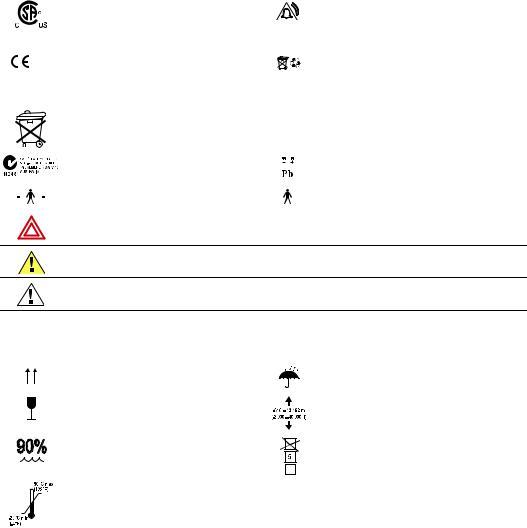
2 |
Chapter 1 General Information |
Welch Allyn Vital Signs Monitor 300 Series |
Symbols
The symbols illustrated on the following pages appear on the monitor or in this document.
Table 1. Symbols: Certification and Operation
|
|
|
|
|
This device has been tested and certified by |
|
|
Urgent alarm notification (output to Nurse Call |
|
|
|
|
|
the Canadian Standards Association |
|
|
system) |
|
|
|
|
|
International to comply with applicable U.S. |
|
|
|
|
|
|
|
|
and Canadian medical safety standards. |
|
|
|
0123 |
The CE Mark and Notified Body Registration |
|
|
Recycle used batteries properly and in |
||||
Number signify that the device meets all |
|
|
accordance with local regulations. |
|||||
|
|
|
|
|
|
|
||
|
|
|
|
|
essential requirements of the European |
|
|
Do not dispose of batteries in refuse containers. |
|
|
|
|
|
Medical Device Directive 93/42/EEC. |
|
|
|
|
|
|
|
|
Recycle the monitor and battery separately from |
other disposables. (See “Recycling Monitor Components” |
||
|
|
|
|
|
on page 70.) |
|
|
|
|
|
|
|
|
|
|
|
|
|
|
|
|
|
Australian Registered Importer |
|
|
Sealed lead-acid battery, 6V 4 Ah |
|
|
|
|
|
|
|
||
|
|
|
|
|
|
|
|
|
|
|
|
|
|
|
|
|
|
|
|
|
|
|
Patient connections (NIBP/Temp) are Type BF, |
|
|
Patient connections (SpO2) are Type BF. |
|
|
|
|
|
|
|
||
|
|
|
|
|
and protected against defibrillation. |
|
|
|
|
|
|
|
|
|
|
|
|
|
|
|
|
|
|
|
|
|
WARNING Indicates conditions that could lead to illness, injury, or death.
Caution In this manual, indicates conditions that could damage equipment or other property.
Caution On the product, means “Consult accompanying documentation.”
Table 2. Symbols: Shipping, Storing, and Environment
|
|
Keep this end of the package or shipping |
|
|
Protect the monitor from exposure to rain. |
|
|
crate up. |
|
|
|
|
|
|
|
|
|
|
|
|
|
|
|
|
|
Fragile contents—handle with care. |
|
|
Do not subject the monitor to altitudes outside |
|
|
|
|
|
these limits. |
|
|
|
|
|
|
|
|
Do not expose the monitor to relative |
|
|
Limit stacking to this number of units. |
|
|
humidity above this limit. |
|
|
|
|
|
|
|
|
|
|
|
|
|
|
|
|
|
|
|
|
|
|
|
Do not expose the monitor to temperatures |
|
|
|
|
|
outside these limits. |
|
|
|
|
|
|
|
|
|
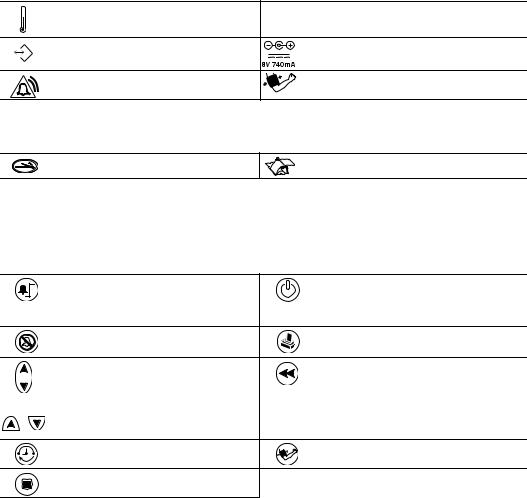
Directions for Use Chapter 1 General Information 3
Table 3. Symbols: Connectors
Temperature Probe Cable Connector |
SpO2 SpO2 Sensor Cable Connector |
RS232 Cable Connector |
AC Power Adapter Cable Connector |
Nurse Call Cable Connector |
NIBP Hose Connector |
Table 4. Symbols: Printer Door
Press to open the printer door |
Load paper this direction |
The functions of the monitor front panel controls illustrated here are described in detail elsewhere in this document.
Table 5. Front Panel Controls
Set alarm limits |
Power on/off |
Silence alarms |
Print patient data |
Scroll up/down |
Review patient data |
Scroll forward/back |
|
Increase/decrease value |
|
(The scroll icon appears as these two arrows |
|
in the documentation.) |
|
Set an NIBP automatic measurement interval |
Start/stop an NIBP cycle (AUTO button) |
Cycle to the next menu selections |
|
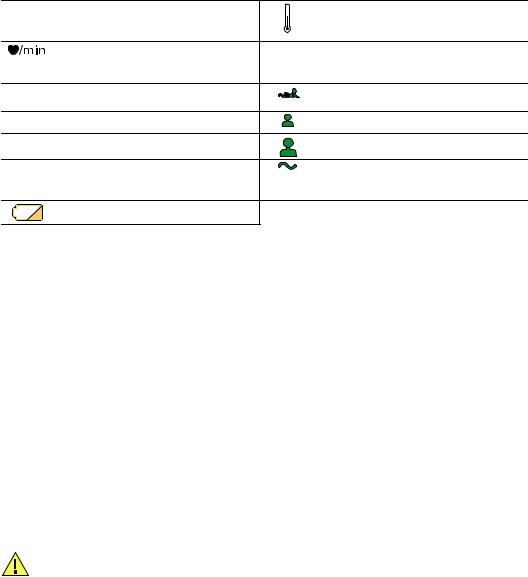
4 Chapter 1 General Information Welch Allyn Vital Signs Monitor 300 Series
Table 6. Front Panel Displays and Indicators
SYS |
Systolic pressure |
|
Temperature |
DIA |
Diastolic pressure |
|
|
SpO2 |
Arterial hemoglobin oxygen saturation |
|
|
|
Pulse rate |
pulse |
Pulse strength |
|
|
amplitude |
|
|
|
indicator |
|
message |
MAP (mean arterial pressure) |
|
Neonatal |
window |
|
|
|
ºC |
Degrees Celsius |
|
Pediatric |
|
|
|
|
ºF |
Degrees Fahrenheit |
|
Adult |
|
|
|
|
M |
Monitored temperature |
|
AC power |
|
|
Battery charging (flashing) |
|
|
|
|
|
|
|
|
Battery charged (steady) |
|
Battery discharged |
|
|
Product Overview
The monitor can monitor systolic and diastolic noninvasive blood pressure (NIBP), pulse rate, and MAP (mean arterial pressure). Units configured with the appropriate options can also simultaneously monitor temperature and SpO2, and can continuously monitor pulse rate.
All vital-sign measurements are displayed on the front panel of the monitor. These measurements can also be printed, using the optional integrated thermal printer.
The monitor provides programmable audible and visual alarms and automatic NIBP measurements at selectable intervals. It can also be configured to provide an alarmactivated Nurse Call function.
Accessory equipment connected to the analog and digital interfaces must be certified to the respective IEC standards (IEC 60950 for data-processing equipment, IEC 60601-1 for medical equipment). All such configurations must comply with system standard
IEC 60601-1-1.
Caution Anyone connecting additional equipment to the signal input part or signal output part of this monitor configures a medical system and is responsible for verifying that the system complies with the requirements of the system standard IEC 60601-1-1.

Directions for Use |
Chapter 1 General Information |
5 |
Warnings and Cautions
All operating and service personnel must be familiar with the information presented here, and with other warnings and cautions which appear throughout this document.
Warning and caution labels can appear on the monitor, the packaging, the shipping container, or in this document.
General Warnings
WARNING Many environmental variables, including patient physiology and clinical application, can affect the accuracy and performance of the device. The clinician must verify all vital signs information prior to patient intervention.
WARNING The monitor is for use only by medical clinicians. Although this document might illustrate medical monitoring techniques, the monitor must be used only by trained clinicians who know how to take and interpret a patient’s vital signs.
WARNING Disconnect the SpO2 cable from the monitor before defibrillating the patient.
WARNING During defibrillation, keep the defibrillation discharge paddles away from any conductive parts that might already be in contact with the patient.
WARNING For the safety of patients, and to ensure the best product
performance and accuracy, use only accessories and supplies recommended or supplied by Welch Allyn for the monitor, as listed in Products and Accessories
(810-0409-XX). Always use accessories with strict adherence to the manufacturer’s directions for use.
WARNING Do not operate the monitor in the presence of magnetic resonance imaging (MRI) or hyperbaric chambers.
WARNING Do not operate the monitor in the presence of a flammable anesthetic mixture with air, oxygen, or nitrous oxide, or in oxygen-enriched environments, or in any other potentially explosive environment.
WARNING It is the clinician’s responsibility to set or verify alarm limits appropriate to each patient.
WARNING Never allow any liquid to enter any monitor connector. If a connector does come in contact with liquid:
1.Remove the monitor from service.
2.Use warm, dry air to dry the connector.
3.Thoroughly test and verify operation before returning the monitor to service.

6 |
Chapter 1 General Information |
Welch Allyn Vital Signs Monitor 300 Series |
WARNING Do not connect more than one patient to a monitor.
WARNING If the monitor is dropped or damaged, it must be thoroughly tested by a qualified service person before it is returned to service.
WARNING Periodically check all cords and cables for damage, wear, or fraying; replace as needed.
WARNING The monitor contains no operator-serviceable parts, other than the replaceable paper roll.
WARNING If the battery shows any signs of damage, leakage, or cracking, it must be replaced immediately, by a qualified service person, and only with a battery approved by Welch Allyn.
WARNING Always recycle batteries according to local regulations. Never dispose of batteries in refuse containers.
WARNING Do not use the monitor on patients who are linked to a heart machine or a lung machine.
WARNING Do not use the monitor on patients who are experiencing convulsions or tremors.
General Cautions
Caution If the accuracy of any measurement is in doubt, verify the patient’s vital sign by another method. If the monitor is not measuring accurately, have it inspected by a qualified service person.
Caution Be sure that the monitor is securely located on a flat surface or properly suspended by means of appropriate mounting equipment.
Caution Do not autoclave the monitor.
Caution Do not place cups, glasses, or other fluid containers or vessels on the monitor.
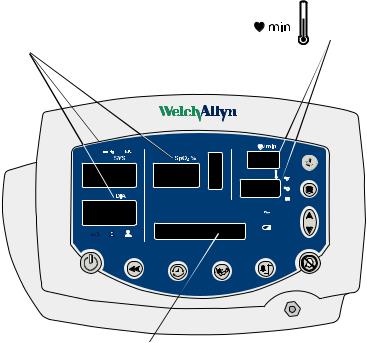
Directions for Use |
Chapter 1 General Information |
7 |
Displays, Indicators, Controls, and Connections
This section describes the measurement displays, status indicators, function controls, and connections of the monitor.
Numeric Measurement and Message Displays
SYS, DIA, and SpO2. Displays systolic and diastolic blood pressure and SpO2, or related alarm thresholds and error codes. (See “Error Codes” on page 60.) 
Displays pulse rate and temperature, or related alarm thresholds and error codes.
(Message window)
Displays the current date and time, MAP measurements, and alarm thresholds. Displays configuration settings, error codes, software version numbers, and printer status.
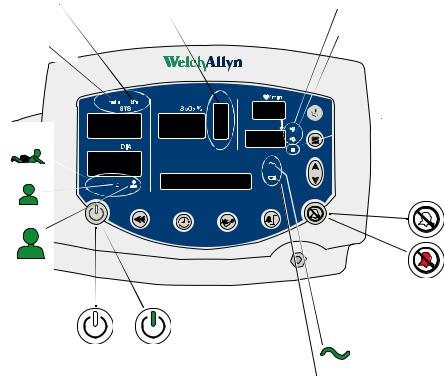
8 |
Chapter 1 General Information |
Welch Allyn Vital Signs Monitor 300 Series |
Status Indicators
NIBP Measurement Units |
Pulse |
||
kilopascals |
kPa |
||
Amplitude Indicator |
|||
millimeters of |
mmHg |
|
|
mercury |
|
|
|
Patient type
neonate
pediatric
adult
|
|
power |
power |
is off |
is on |
Temperature Units
ºF |
degrees Fahrenheit |
ºC |
degrees Celsius |
|
Temperature Type |
|
M monitored |
|
alarms not silenced |
alarms silenced
Battery Status
charged ———
charging - - - - -
 discharged
discharged
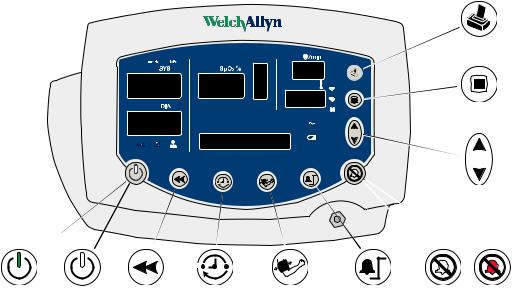
Directions for Use |
Chapter 1 General Information |
9 |
Function Controls
Menu
|
|
|
|
|
|
|
Up/Down |
Power On/Off |
|
|
|
|
|
|
|
Power |
Power |
Review |
Set NIBP |
Start/Stop NIBP |
Set Alarm |
Silence |
Alarms |
is on |
is off |
Data |
Interval |
(AUTO button) |
Limits |
Alarms |
Silenced |
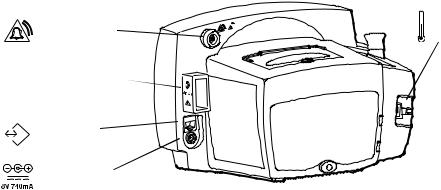
10 |
Chapter 1 General Information |
Welch Allyn Vital Signs Monitor 300 Series |
Connections
|
Nurse Call Cable |
|
Connector |
SpO2 |
SpO Sensor Cable |
|
2 |
|
Connector |
|
RS232 Cable |
|
Connector |
|
DC Power Cable |
|
Connector |
|
. |
30V |
, 1A Max |
For information on the connections, refer to the following:
Temperature Probe
Cable Connector
AC Power Adapter |
“Connecting AC Power” on page 11 |
|
|
Temperature Probe |
“Connecting the Temperature Probe Cable” on page 14 |
|
|
SpO2 Sensor |
“Connecting and Disconnecting the SpO2 Sensor Cable” on page 15 |
NIBP Cuff Hose |
“Connecting the NIBP Cuff Hose” on page 13 |
|
|
Nurse Call Cable |
“Nurse Call” on page 81 |
|
|
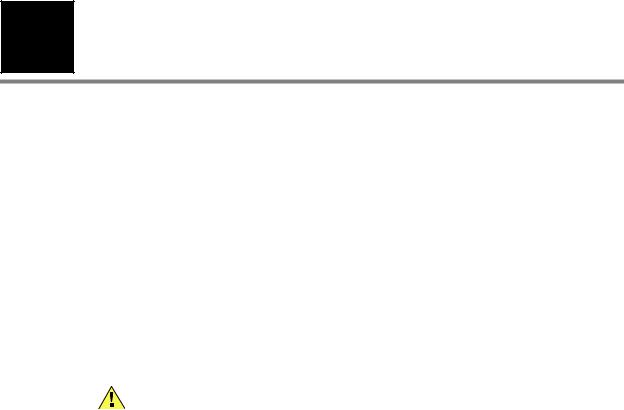
11
2 Setup
This chapter describes the set-up procedures for patient monitoring.
Connections
Use the procedures described below to connect components to the monitor.
Connecting AC Power
The monitor operates on DC power, supplied by either the internal battery or the AC power adapter. (For information on the battery, refer to “Battery Operation” on page 71 and “Electrical” on page 76.)
When the AC power adapter is connected, it simultaneously powers the monitor and charges the internal battery. When the AC power adapter is not connected, the monitor operates on the internal battery.
Caution Use only the medical-grade AC power adapter approved by Welch Allyn. (Refer to the Welch Allyn Parts and Accessories Guide (810-0409-XX) for ordering information.) Using an unqualified power adapter can have the following results:
•violation of isolation requirements
•hazard to the patient
•damage to the monitor
•nullification of the product warranty
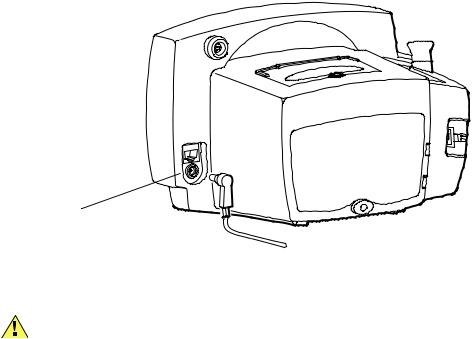
12 |
Chapter 2 Setup |
Welch Allyn Vital Signs Monitor 300 Series |
To use the AC power adapter:
1.Plug the power adapter into the AC power source.
2.Plug the power adapter connector into the monitor DC port.
AC Power
Adapter Port
Use the AC power adapter to fully charge the battery before using the monitor. (This can take up to 12 hours.)
Caution Fully charge the battery before using the monitor for the first time. Failure to do so will result in poor battery performance and reduced battery life.
•While the monitor is charging, the AC/charging indicator  flashes.
flashes.
•When the monitor is 90% charged, the AC/charging indicator  is steady. To fully charge the battery, leave the AC power adapter connected for a few more hours.
is steady. To fully charge the battery, leave the AC power adapter connected for a few more hours.
•After the monitor is fully charged for the first time, the monitor can be powered by the AC power adapter or by the internal battery.
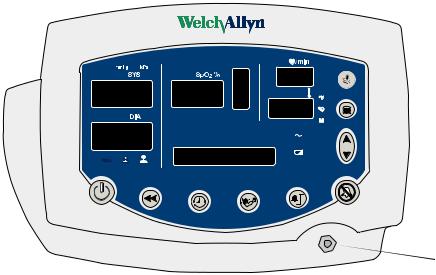
Directions for Use |
Chapter 2 Setup |
13 |
Connecting the NIBP Cuff Hose
Attach the hose to the monitor and the cuff as follows, referring to the illustration below:
1.Screw the hose connector onto the NIBP connector on the monitor.
2.Connect the monitor hose connector to the mating connector on the cuff.
Threaded NIBP
Hose Connector
For information on NIBP measurements, see “Patient Monitoring” on page 31.
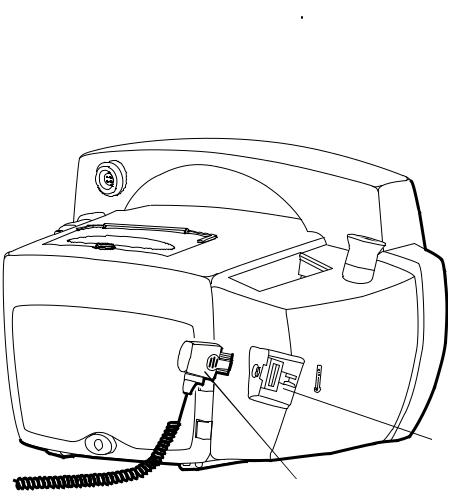
14 |
Chapter 2 Setup |
Welch Allyn Vital Signs Monitor 300 Series |
Connecting the Temperature Probe Cable
Follow these steps to connect the temperature probe cable to the monitor.
1.Locate the temperature probe connector port  on the back of the monitor.
on the back of the monitor.
2.Holding the temperature probe cable connector with the spring tab on the right, carefully insert it into the monitor temperature probe connector port. The spring tab clicks out when the connector halves are fully and correctly mated.
3.To disconnect the temperature probe cable, depress the spring tab and withdraw the cable connector.
 Temperature Probe
Temperature Probe
Connector Port
Temperature Probe Cable
Connector
For information on temperature measurements, see “Patient Monitoring” on page 31.
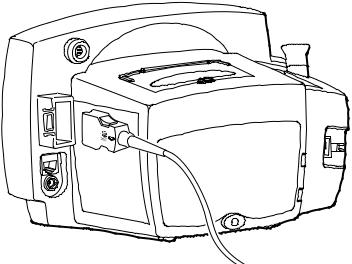
Directions for Use |
Chapter 2 Setup |
15 |
Connecting and Disconnecting the SpO2 Sensor Cable
To connect the SpO2 sensor cable:
1.Locate the SpO2 sensor cable connector (labeled SpO2) on the side of the monitor.
2.Note the hole patterns of the connector halves, and align the cable connector accordingly.
3.Carefully insert the SpO2 cable connector into the SpO2 monitor connector.
If you are using a sensor extension cable, plug the sensor into the extension cable and plug the extension cable into the monitor.
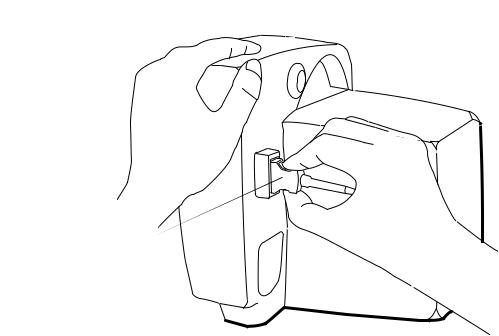
16 |
Chapter 2 Setup |
Welch Allyn Vital Signs Monitor 300 Series |
To disconnect the SpO2 cable, refer to the instructions shown in the illustration below.
Note Always grasp the cable by the connector shoulder. Do not pull on the cable itself.
Thumb and forefinger squeeze the tabs in the shoulder of the connector cable to release the cable connector.
For information on SpO2 measurements, see “Patient Monitoring” on page 31.
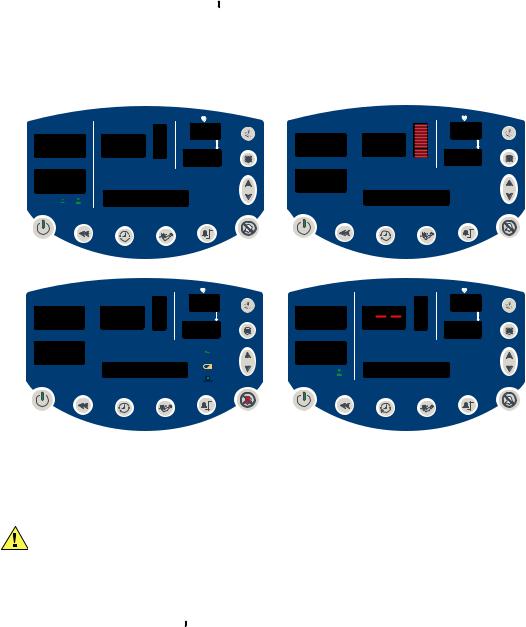
Directions for Use |
Chapter 2 Setup |
17 |
Power On, Power-on Self-Test, and Power Off
When the battery is charged, press  to turn on the monitor.
to turn on the monitor.
The monitor runs a diagnostic self-test each time it powers up.
•If all tested functions are working normally, the various windows briefly display start-up values (‘8’ and ‘- -’) and a short tone sounds twice.
mmHg kPa |
/min |
|
/min |
|
|
|
|
SYS |
SpO2 % |
SYS |
SpO2 % |
8.8.8. |
|
|
18.8. |
DIA |
|
DIA |
|
8.8.8. |
**************** |
|
**************** |
|
|
|
|
1 |
2 |
|
|
|
|
3 |
4 |
|
|
|
|
/min |
mmHg |
|
/min |
|
|
888. . . |
|
0 |
|
SYS |
SpO2 % |
SYS |
SpO2 % |
||
|
|
ºF |
0 |
|
ºF |
DIA |
|
1.8.8.8. ºC |
DIA |
|
|
|
M |
|
|
0
**************** |
00:00:45 |
•If the self-test fails, an error code appears in the SYS window.
When the self-test is complete, the software version appears briefly in the message window, followed by the current time of day.
Caution Always observe the monitor during power-up. If any display fails to illuminate properly, or if an error code appears in the systolic window, inform your biomedical engineering department immediately, or call your nearest Welch Allyn Customer Service or Technical Support facility. Do not use the monitor until the problem is corrected.
To shut off the monitor, press  .
.
Note Shutting off the monitor erases all stored patient data but does not erase settings or configuration parameters.
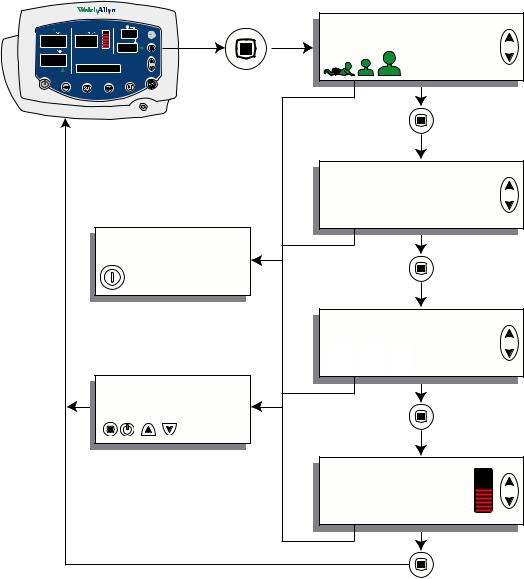
18 |
Chapter 2 Setup |
Welch Allyn Vital Signs Monitor 300 Series |
Configuring Operating Parameters
You can change several monitor operating parameters. When changed, these settings become the default power-up settings.
How to Use the Menu System
The monitor menu system contains three sets of menus—settings, configuration, and service.
Settings Menu
Access the settings menu by pressing the menu button  while in normal operation. Then press
while in normal operation. Then press  repeatedly to reach the setting of interest.
repeatedly to reach the setting of interest.
Settings Menu
128 |
98 |
54 |
|
37.0 |
|||
|
|
||
71 |
MAP 90mmHg |
|
|
|
|
Power Off - all values saved except target inflation pressure
No action for 10 seconds or
Press any button other than
Patient Type
Target Cuff Inflation Pressure
Temperature Units
Temperature Type
ºF ºC M
Pulse Tone Volume
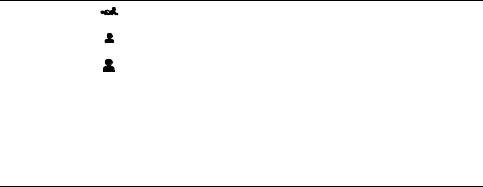
Directions for Use |
Chapter 2 Setup |
19 |
Use the settings menu to select and set the following parameters:
Patient Type |
|
|
Neonate |
Term birth through 28 days, or up to 44 gestational weeks |
|
|
|
Pediatric |
29 days through 12 years |
|
|
|
Adult |
13 years and older |
Target Pressure |
|
|
The initial cuff inflation pressure (set individually for each patient type) |
|
Temp Modes |
ºF |
|
Fahrenheit Predictive |
|
|
ºF |
M |
Fahrenheit Monitored |
|
|
ºC |
|
Celsius Predictive |
|
|
ºC |
M |
Celsius Monitored |
|
Pulse Tone Volume |
|
|
From 0 (silent) to 5 (loudest) |
|
To change a settings parameter:
1.Select the parameter as indicated above.
2.Change the value by pressing  or
or  .
.
3.Set the displayed new value either by doing nothing for 10 seconds or by pressing any button other than  or
or  . If you press a function button (such as
. If you press a function button (such as  ), the monitor returns to normal operation with that function (
), the monitor returns to normal operation with that function ( ) activated.
) activated.
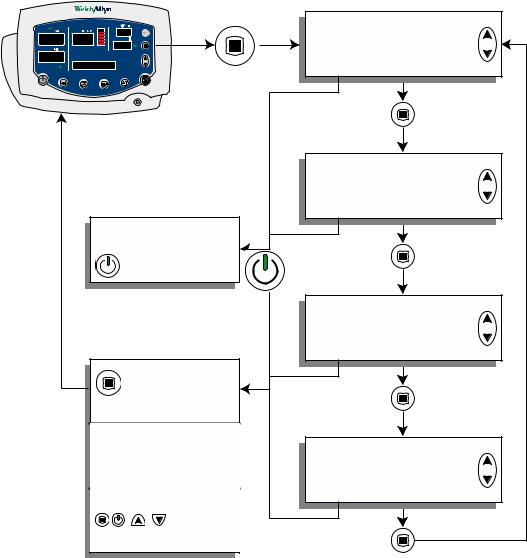
20 |
Chapter 2 Setup |
Welch Allyn Vital Signs Monitor 300 Series |
Configuration Menu
The configuration menu is accessed by pressing  and keeping it depressed for three seconds. You then press
and keeping it depressed for three seconds. You then press  repeatedly until you reach the setting of interest.
repeatedly until you reach the setting of interest.
Configuration Menu
128 |
98 |
54 |
|
37.0 |
|||
|
|
||
71 |
MAP 90 kPa |
Press and hold |
|
|
|||
|
|
||
|
|
for 3 seconds |
Power Off - all values saved
Press and hold for 3 seconds
No action for 10 seconds
Press any button other than
Set Time and Date
MAP
Enable
Disable
NIBP Units mmHg kPa
Stream
Batch

Directions for Use |
Chapter 2 Setup |
21 |
Use the configuration menu to select and set the following parameters:
Time and Date |
hour |
|
minute |
|
year |
|
month |
|
day |
MAP Measurement |
Enabled |
|
Disabled |
Blood Pressure |
mmHg (millimeters of mercury) |
Measurement Units |
kPa (kilopascals) |
Print Mode |
Batch |
|
Stream |
|
|
To change a configuration parameter:
1.Select the parameter as indicated above.
2.Change the value by pressing  or
or  .
.
3.Set the displayed new value either by doing nothing for 10 seconds or by pressing any button other than  or
or  . If you press a function button (such as
. If you press a function button (such as  ), the monitor returns to normal operation with that function (
), the monitor returns to normal operation with that function ( ) activated.
) activated.
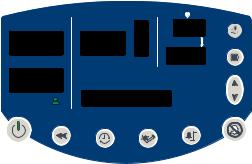
22 |
Chapter 2 Setup |
Welch Allyn Vital Signs Monitor 300 Series |
Changing the Time and Date
Follow these steps to change the time and date settings of the monitor internal clock.
1.Press and hold  for 3 seconds. SET HOUR XX appears in the message window.
for 3 seconds. SET HOUR XX appears in the message window.
/min
mmHg
SYS |
SpO2 % |
ºF
DIA
SET HOUR 00
2.Press  or
or  as needed to change XX to the current hour.
as needed to change XX to the current hour.
3.Press  once to set the hours and change the display to SET MINUTE XX.
once to set the hours and change the display to SET MINUTE XX.
4.Press  or
or  as needed to change XX to the current minute.
as needed to change XX to the current minute.
5.Press  once set the minutes and to change the display to SET YEAR XX.
once set the minutes and to change the display to SET YEAR XX.
6.Press  or
or  as needed to change XX to the current year.
as needed to change XX to the current year.
7.Press  once to set the year and change the display to SET MONTH XXX.
once to set the year and change the display to SET MONTH XXX.
8.Press  or
or  as needed to change XXX to the current month.
as needed to change XXX to the current month.
9.Press  once to set the month and change the display to SET DAY XX.
once to set the month and change the display to SET DAY XX.
10.Press  or
or  as needed to change XX to the current day.
as needed to change XX to the current day.
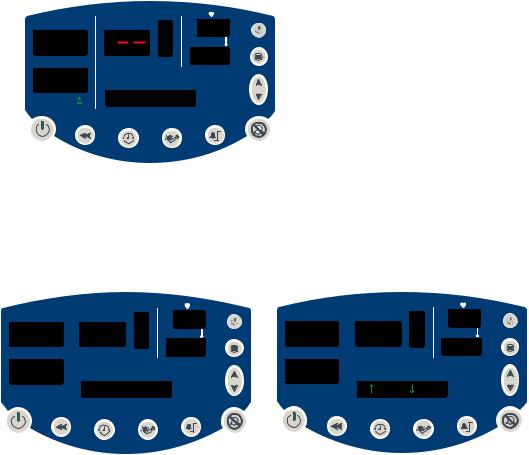
Directions for Use |
Chapter 2 Setup |
23 |
11.To save the displayed time and date settings, either do nothing for 10 seconds or
press any button other than  or
or  . If you press a function button (such as
. If you press a function button (such as  ), the monitor returns to normal operation with that function (
), the monitor returns to normal operation with that function ( ) activated.
) activated.
mmHg |
|
/min |
|
|
0 |
||
SYS |
SpO2 % |
||
|
0 |
ºF |
DIA
0
09:24:17
You cannot change the date and time while memory contains stored vital-signs data. If you attempt to change the date and time setting while data is stored, the question ERASE DATA? appears in the message window. If you confirm the data erasure, the monitor erases the data from memory and returns you to the date-set function. If you select NO, the stored data is retained in memory and the monitor returns to normal operation.
|
/min |
|
/min |
SYS |
SpO2 % |
SYS |
SpO2 % |
DIA |
|
DIA |
|
|
ERASE DATA? |
|
= YES = NO |
